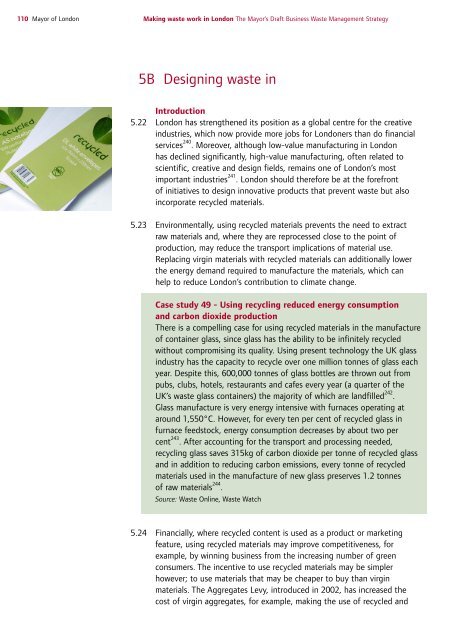Draft Business Waste Strategy PDF - london.gov.uk - Greater ...
Draft Business Waste Strategy PDF - london.gov.uk - Greater ...
Draft Business Waste Strategy PDF - london.gov.uk - Greater ...
You also want an ePaper? Increase the reach of your titles
YUMPU automatically turns print PDFs into web optimized ePapers that Google loves.
110 Mayor of London<br />
Making waste work in London The Mayor’s <strong>Draft</strong> <strong>Business</strong> <strong>Waste</strong> Management <strong>Strategy</strong><br />
5B Designing waste in<br />
Introduction<br />
5.22 London has strengthened its position as a global centre for the creative<br />
industries, which now provide more jobs for Londoners than do financial<br />
services 240 . Moreover, although low-value manufacturing in London<br />
has declined significantly, high-value manufacturing, often related to<br />
scientific, creative and design fields, remains one of London’s most<br />
important industries 241 . London should therefore be at the forefront<br />
of initiatives to design innovative products that prevent waste but also<br />
incorporate recycled materials.<br />
5.23 Environmentally, using recycled materials prevents the need to extract<br />
raw materials and, where they are reprocessed close to the point of<br />
production, may reduce the transport implications of material use.<br />
Replacing virgin materials with recycled materials can additionally lower<br />
the energy demand required to manufacture the materials, which can<br />
help to reduce London’s contribution to climate change.<br />
Case study 49 - Using recycling reduced energy consumption<br />
and carbon dioxide production<br />
There is a compelling case for using recycled materials in the manufacture<br />
of container glass, since glass has the ability to be infinitely recycled<br />
without compromising its quality. Using present technology the UK glass<br />
industry has the capacity to recycle over one million tonnes of glass each<br />
year. Despite this, 600,000 tonnes of glass bottles are thrown out from<br />
pubs, clubs, hotels, restaurants and cafes every year (a quarter of the<br />
UK’s waste glass containers) the majority of which are landfilled 242 .<br />
Glass manufacture is very energy intensive with furnaces operating at<br />
around 1,550°C. However, for every ten per cent of recycled glass in<br />
furnace feedstock, energy consumption decreases by about two per<br />
cent 243 . After accounting for the transport and processing needed,<br />
recycling glass saves 315kg of carbon dioxide per tonne of recycled glass<br />
and in addition to reducing carbon emissions, every tonne of recycled<br />
materials used in the manufacture of new glass preserves 1.2 tonnes<br />
of raw materials 244 .<br />
Source: <strong>Waste</strong> Online, <strong>Waste</strong> Watch<br />
5.24 Financially, where recycled content is used as a product or marketing<br />
feature, using recycled materials may improve competitiveness, for<br />
example, by winning business from the increasing number of green<br />
consumers. The incentive to use recycled materials may be simpler<br />
however; to use materials that may be cheaper to buy than virgin<br />
materials. The Aggregates Levy, introduced in 2002, has increased the<br />
cost of virgin aggregates, for example, making the use of recycled and
















